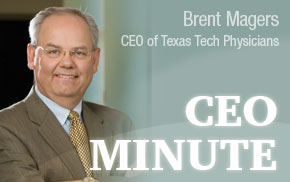 When I was a boy growing up in Gainesville, Texas, everybody knew our town’s doctors.
There was Dr. Lusk, Dr. Powell, Dr. Cole and a few others. Each of them was independent,
meaning they were solo in their practice and operated their own small clinic. About
the only time we would see two doctors together was when we had a father-and-son combination.
This independent model is also what I experienced for the first several years of my
career in health care. But, not today.
When I was a boy growing up in Gainesville, Texas, everybody knew our town’s doctors.
There was Dr. Lusk, Dr. Powell, Dr. Cole and a few others. Each of them was independent,
meaning they were solo in their practice and operated their own small clinic. About
the only time we would see two doctors together was when we had a father-and-son combination.
This independent model is also what I experienced for the first several years of my
career in health care. But, not today.Today’s physician is evolving from self-employed practitioner to somebody's employee. This is not just my casual observation. According to Merritt Hawkins, one of the nation’s largest physician recruitment firms, 64 percent of physician search assignments from April 1, 2012, to March 31, 2013, came from hospitals looking to hire. In 2004, hospitals generated just 11 percent of physician searches. That is quite a change.
And, it is not just hospitals looking to hire doctors; it is other organizations like retail clinics, urgent care centers, freestanding emergency departments and community health centers. According to Merritt Hawkins, between 85 percent and 90 percent of all search assignments involve some form of physician employment compared with 30 percent in 2004.
What specialties are most recruited? Primary care tops the list, with first place belonging to family physicians and second to general internists. Finishing out the top 10 are hospitalists, psychiatry, emergency medicine, pediatrics, OB-GYN, general surgery and neurology.
We are witnessing the demise of the solo practitioner — the lone physician who hangs out a shingle and assumes all of the financial risks of an independent practice along with the responsibility for managing it. I am not saying this is good or bad, just that it is a trend worth noting.
